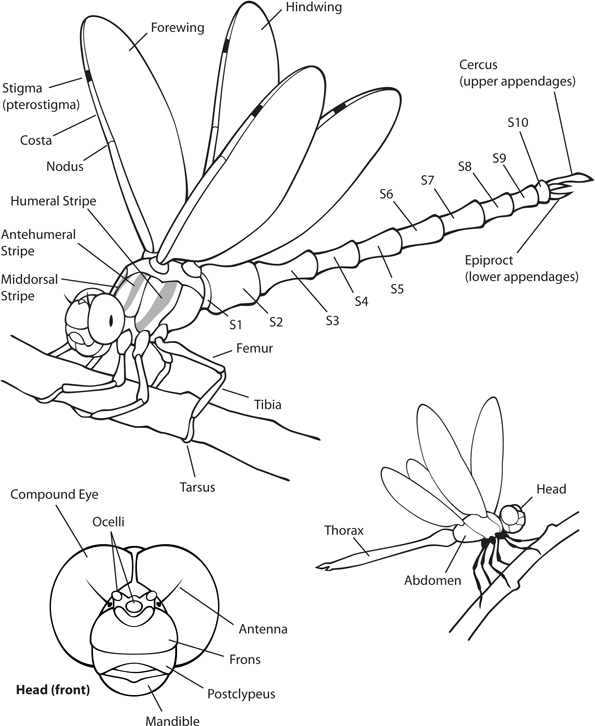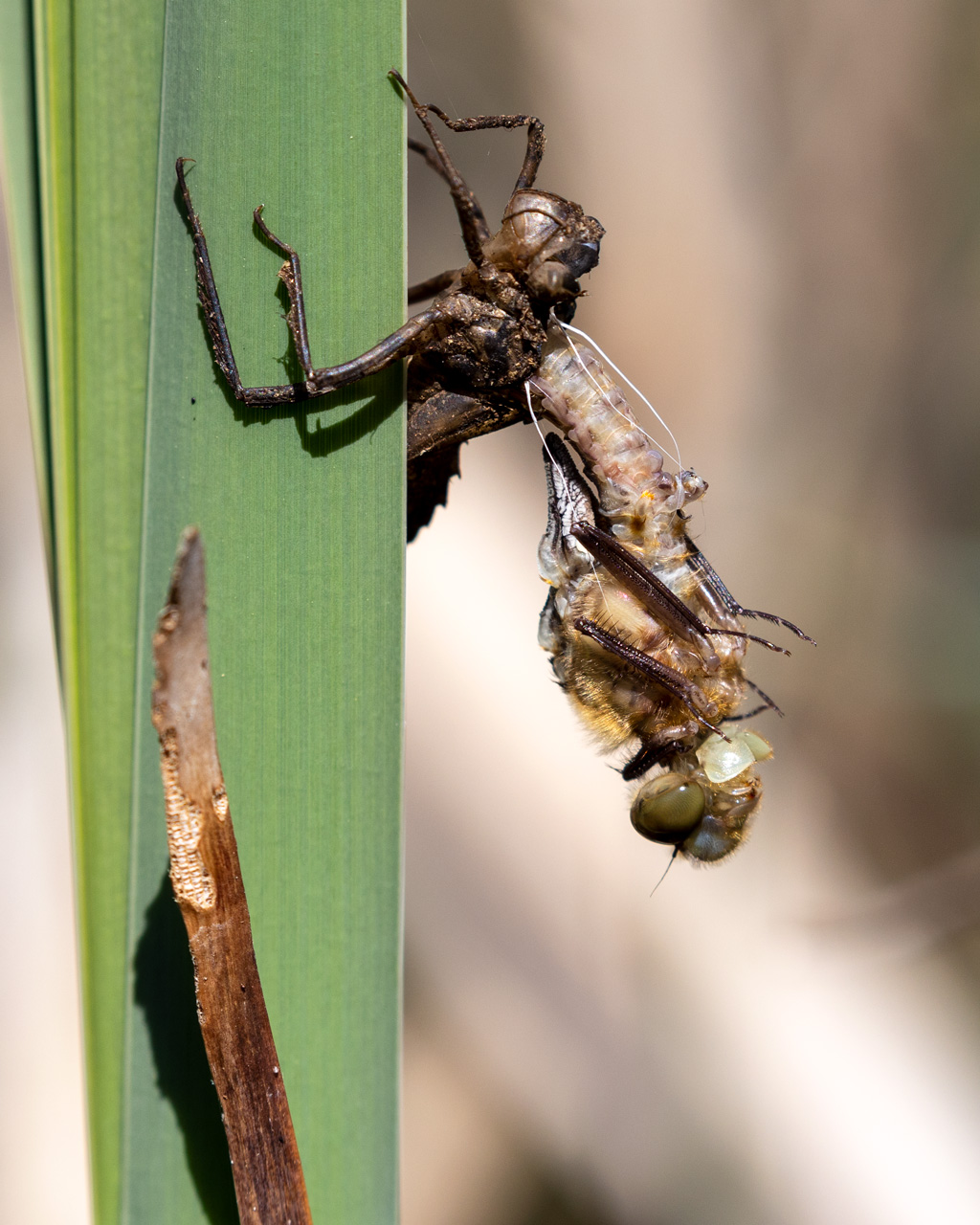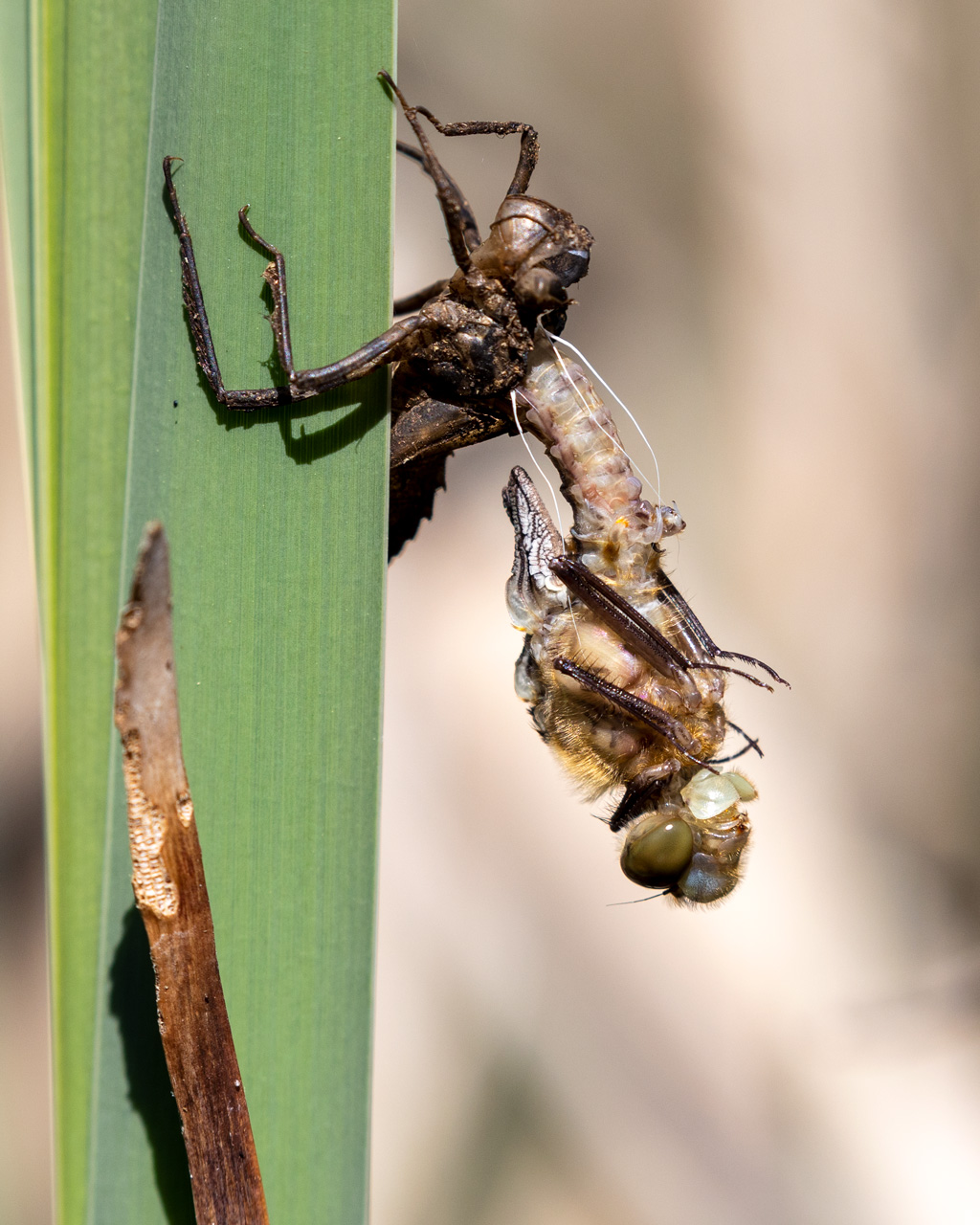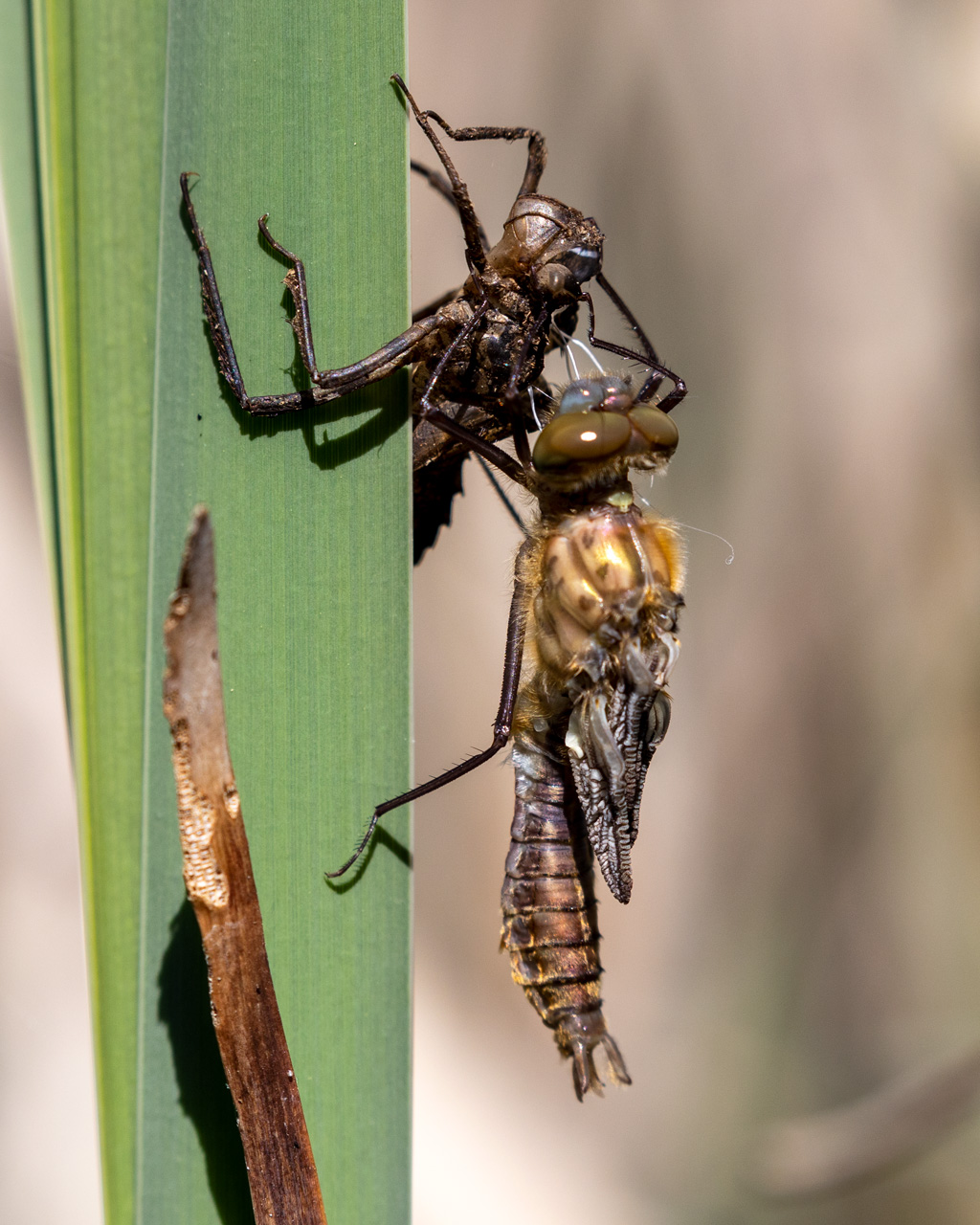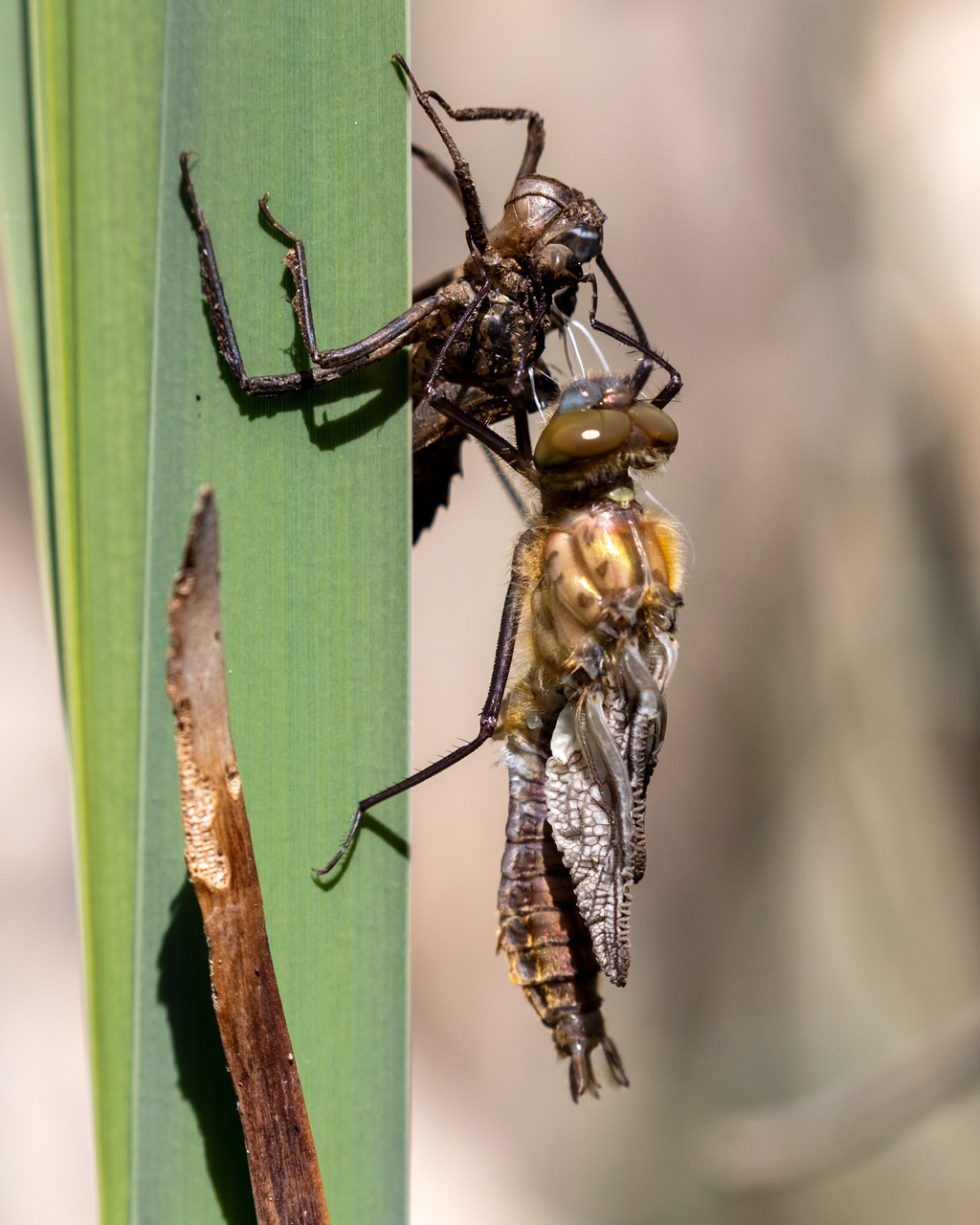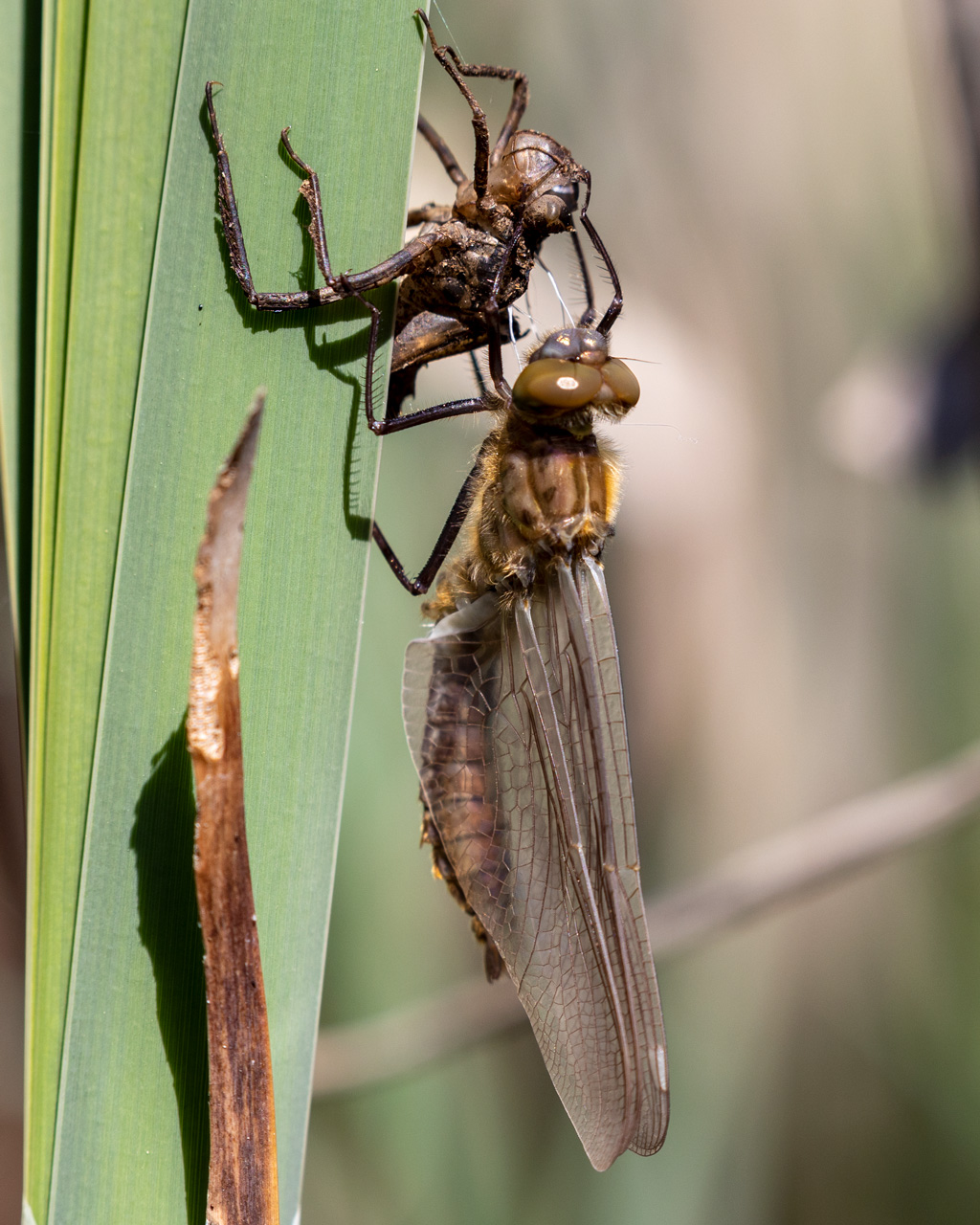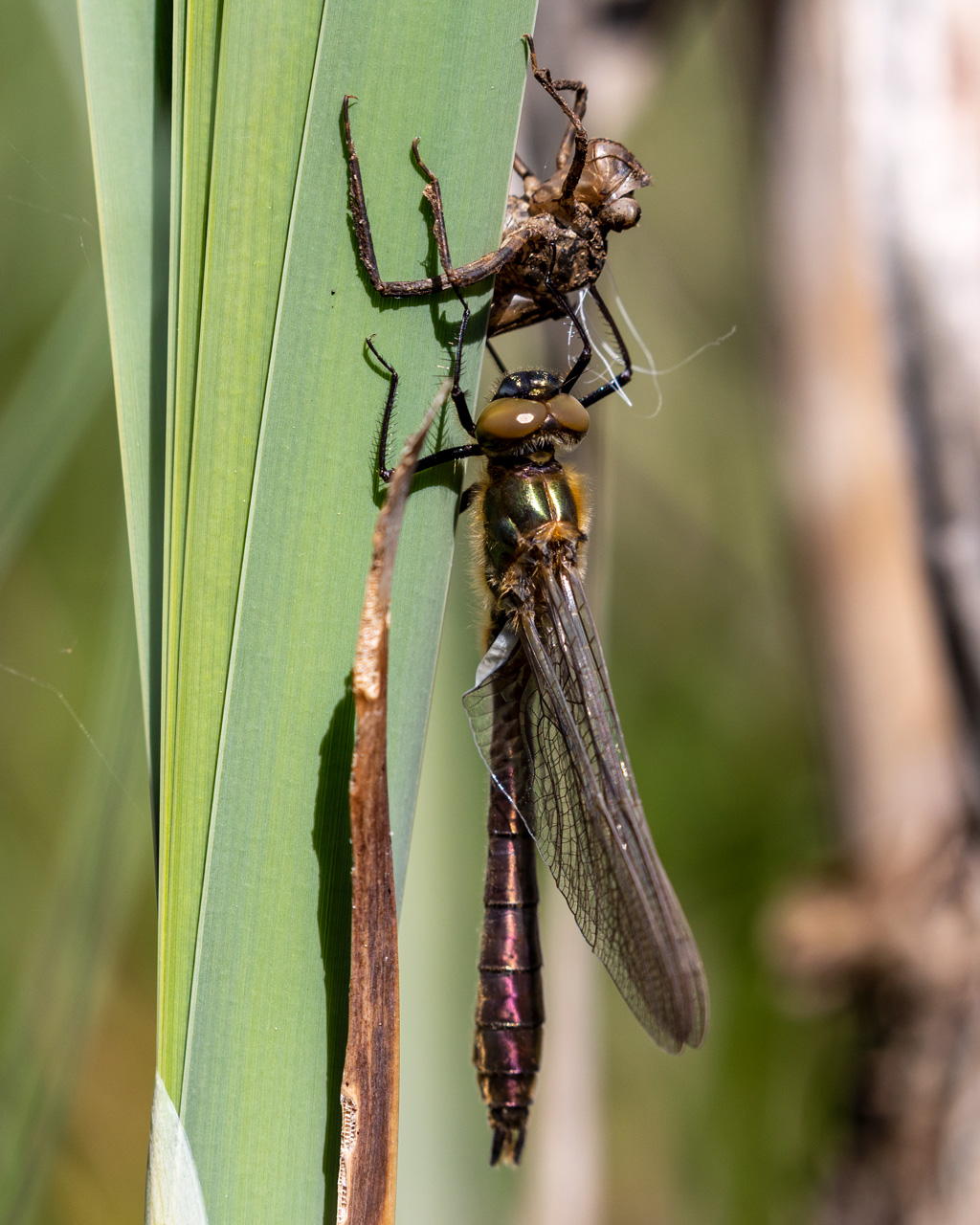Anatomy
Insects of the order Odonata (odonates) are divided in two suborders: Zygoptera and Epiprocta. Zygoptera includes the broad-winged damsels, spreadwings, pond damsels, and shadowdamsels. They can generally be recognized by the fact that (a) the wings at rest are held parallel to the body (except in spreadwings), (b) the fore- and hindwings are similar, and (c) the eyes are separated.
Most species of the suborder Epiprocta belong to the infraorder Anisoptera, which includes the darners, clubtails, spiketails, and skimmers. In Anisoptera, (a) the wings at rest are held perpendicular to the body, (b) the hindwings broaden at the base, and (c) the eyes come close to or touch each other at the top of the head. Zygoptera are often smaller and have a weaker flight than Anisoptera.
All odonates have the same basic body plan consisting of a head, thorax carrying three pairs of legs and two pairs of wings, and abdomen. Most of the head consists of the compound eyes and the mouth and associated parts. The thorax contains the muscles that control the movements of the wings and legs whereas the abdomen, which is divided in 10 segments, contains the digestive and reproductive systems.
Below are drawings showing the main external structural characteristics of damselflies and dragonflies (source: Arizona Dragonflies)
Biology
There are three stages in the life-cycle of all dragonflies. The egg hatches into the larva (also known as a nymph), which moults up to 15 times before emerging as an adult. Unlike most other insects, there is no pupal stage and the transition from larva to adult is known as incomplete metamorphosis. This is not necessarily an annual cycle, since the larva may spend more than a year underwater before emerging as an adult. The adult stage is usually the shortest in the life-cycle and rarely lasts for more than a week or two.
Egg
Female dragonflies can lay hundreds of eggs during their adult lives, in batches over a few days or even weeks. Eggs are laid either into plant material (endophytic eggs) or deposited loosely into water (exophytic eggs). The former are elongated, but the latter are rounded and laid in a jelly-like substance which confers some protection.
All damselflies and the hawkers have scythe-like ovipositors and inject their eggs into plant stems or leaves, rotten wood or mud on or close to the surface of the water. Some damselflies submerge completely to lay their eggs, often using their still-attached partner to pull them up again afterwards. Emerald damselflies and Migrant Hawkers inject their eggs into rush stems well above the water surface, while other hawkers lay into rotten wood or other debris just above the waterline. The Golden-ringed Dragonfly lays its eggs by hovering vertically and stabbing its abdomen into stream-beds. Other species, including the emerald dragonflies, chasers, skimmers and darters, repeatedly dip the tips of their abdomens into water, each time releasing one or more eggs that settle below the surface.
During egg-laying, male damselflies, chasers, skimmers and darters guard the females with which they have just mated, either by staying linked ‘in tandem’ or by flying in close attendance. Female dragonflies often attract attention whilst they are egg-laying as their wings rustle against emergent plants.
Eggs hatch either within 2–5 weeks or, in the case of the emerald damselflies and some hawkers and darters, the following spring.
Larva
What emerges from the egg is tiny and tadpole-like, and designed to escape from the egg. In cases where the egg is laid above the waterline, this ‘prolarva’ wriggles to safety as soon as it hatches and moults within a few hours. Prolarvae emerging from eggs laid below the waterline moult almost immediately after hatching. During its time as a larva, the dragonfly catches and eats live prey at every opportunity, moulting a further 5–14 times until it is fully-grown.
Larval development typically takes one or two years, but ranges from 2–3 months in the case of the emerald damselflies to more than five years in Golden-ringed Dragonfly. Development takes longer in cooler waters where food is scarcer, whilst in warm waters, such as those of southern Europe, there may be more than one generation per year. With global warming, two generations per year may become increasingly possible for some species in Britain and allow southern species, such as Red-veined Darter, to become firmly established. In any case, it is worth remembering that dragonflies spend most of their lives underwater and only pass a few days or weeks in the adult form.
All dragonfly larvae have six legs (as do adults), wing-sheaths, a hinged jaw (labium) that can shoot out in an instant and catch prey, and the ability to breathe underwater. The labium is flattened in damselflies and hawkers, but spoon-shaped in other dragonflies. The appearance and habits of each species have evolved so that they can occupy different niches and avoid competition and predation.
The larvae of some species are covered in hairs that collect silt or organic debris from the soft sediment within which they live. Others are coloured green and/or brown, which helps to provide camouflage amongst the submerged plants and algae they inhabit. Species living in bottom sediments have relatively poor eyesight, but instead use their hairs, long legs and antennae to sense prey. In contrast, hawkers have large eyes and hunt by sight amongst plants nearer the surface.
Prey includes insect larvae, crustaceans, worms, snails, leeches, tadpoles and small fish. Many species no doubt benefit from the annual abundance of frog, toad and newt tadpoles, which make for relatively easy meals during late winter and spring. Water-fleas and midge larvae can also provide abundant food sources, especially for damselflies and smaller dragonflies. Of course, dragonfly larvae themselves can fall victim to predators, including other dragonfly larvae, fish and waterfowl. If any limbs or caudal lamellae are lost to predators, however, there is an opportunity to replace them at each moult.
Generally, the best larval habitats have a wide variety of niches created through a varied aquatic flora, and have mainly unshaded, unpolluted and permanent water. Few species are able to cope with highly nutrient-enriched water, but many are tolerant of acidic water, such as that usually associated with heathland, where they benefit from the absence of predatory fish.
Emergence
Unlike other winged insects, such as butterflies, dragonflies do not have a pupal stage, but progress to adults through a final larval moult that takes place out of water. Triggered by day length and temperature, emergence is synchronised in some species, such as Emperor Dragonfly, which emerge in spring, but is more extended in the later-emerging species.
Final-stage larvae sit in shallow water near the margins for several days, getting ready for their final moult and starting to breathe air. Most species leave the water during the morning, but hawkers do so under cover of darkness. Larvae climb up robust emergent vegetation, although some may walk several metres over dry land before finding somewhere suitable. After finding a secure support, they redistribute their body fluids – first to push the thorax, head, legs and wings out of the larval skin. There is then a pause of about 30 minutes to allow their legs to harden enough for the next stage, when the abdomen is withdrawn. The wings and then the abdomen are expanded and start to harden. This process leaves behind a cast skin, called an exuvia, and lasts for between one hour (in the case of damselflies) and three hours (in the case of dragonflies).
Maiden flights are weak and typically cover only a few metres. However, in very warm conditions some species, such as Scarce Blue-tailed Damselfly, may rise into the air and drift for long distances at high altitude. At such times, dragonflies are especially vulnerable to predation by birds such as the Hobby. Smaller predators, such as Blackbirds, spiders and ants, also take a heavy toll during emergence. Other hazards include physical obstructions or rainfall, which can result in many individuals suffering from imperfectly expanded wings or damage to the soft tissues.
Adult
Newly-emerged adult dragonflies, known as tenerals, are a pale green colour at first, with only hints of the final adult patterning. Their wings remain very reflective for a couple of days and the flight is weak and fluttery. As the body and wings harden off, they begin hunting for food whenever fine weather permits. They spend about a week, depending on the weather, feeding away from water and gradually acquire adult colouration and sexual maturity.
When mature, adults move back to the water to breed. The males of some species, notably dragonflies, are territorial and battle constantly to obtain and defend a suitable length of water’s edge. They investigate any potential interloper and especially females, which they will try to seize and mate. The number of adults found at water is determined by the species’ territorial behaviour. Territorial species are always found in smaller numbers than gregarious species, such as the blue damselflies, which may be present in hordes.
Mating in dragonflies is unique. The male first transfers sperm from near the tip of his abdomen to accessory genitalia under the front. He then grasps a female by the ‘scruff of her neck’ with the anal appendages (or ‘claspers’) at the tip of his abdomen: the pair is then said to be ‘in tandem’. If the mood takes her, the female curls the tip of her abdomen to meet the male’s accessory genitalia and sperm is transferred; this position is known as ‘the wheel’, or technically in copula. In some species, such as the chasers, the whole mating process takes only a few seconds; at the other extreme, Blue-tailed Damselflies take up to six hours.
Cross-breeding between different species is prevented by species-specific combinations of the shapes of the male’s anal claspers and the rear of the female’s head (in dragonflies) or pronotum (in damselflies). Although virtually impossible to see in the field, these can provide conclusive proof of identity in some difficult species (as does wing venation).
Egg-laying occurs soon after mating. Females that lay alone frequently have difficulty avoiding the attentions of males and therefore may choose to lay during poorer weather, even in rain.
Adult dragonflies are most active between mid-morning and mid-afternoon, when temperatures are highest. Flight is generally restricted to sunny weather, when the flight muscles in the thorax are sufficiently warm. This is especially the case for species that spend most of their time perched. Alternatively, a tactic used by hawkers, especially females (allowing them to lay eggs during cooler weather), is to generate heat in the flight muscles by vibrating their wings. Generally, though, dragonflies seem to disappear in wet or cool cloudy conditions. In reality, they sit still and well hidden amongst vegetation, often hanging under leaves in trees.
The life-expectancy of adults is short, typically no more than a week or two, but exceptionally 6–8 weeks.


